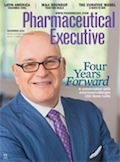From the Editor: Demographic of Distress
Pharmaceutical Executive
A new discipline-population health-contests disease treatment as an end in itself. It asks: besides advancing the science of medicine, what do biopharmaceuticals actually do to improve health overall?
There is more to good health than great medicines. Even the most ardent advocates of biopharmaceutical innovation today concede this to be true. A new discipline-population health-has emerged
William Looney

to contest disease treatment as an end in itself rather than part of a much larger set of behavioral and social factors that determine not just how people get sick, but why they stay well. The pregnant question is: besides advancing the science of medicine, what do biopharmaceuticals actually do to improve health overall?
The answer matters because population health is a hotly contested field for research. Much of this work is conducted without much input from drugmakers, even though the policy assertions that underlie population health practically beg for a robust industry response.
The latest example is a paper published in September by the National Academy of Sciences (NAS) that documents a significant increase in mortality and morbidity among white non-Hispanic middle-aged Americans, between the age of 45 and 54, during the period 1999 to 2013. The findings refute the premise that successive generations can look forward to longer, better, healthier lives. The authors, Princeton professors Anne Case and Angus Deaton attribute this reversal to “increasing distress among whites in midlife.”
Case and Deaton claim the rise in mortality is due to three factors: suicide; alcohol and drug abuse, including overuse of prescription pain opioids; and chronic liver disease.
Increases in morbidity center on quality-of-life conditions: chronic pain; mental illness; impediments to activities of daily living (ADL), such as obesity; and alcohol use. The paper refers to the rising incidence of chronic pain, suicide, and drug overdose among the 45 to 54 demographic as an “epidemic,” while, in a startling contrast, mortality and morbidity rates for the elderly have actually improved.
What got the biggest splash is the authors’ assertion of a connection between this health burden of middle age-prime working years for most people- and the economic insecurity and social exclusion induced by the 2008-2009 recession. This reinforces a central rationale of population health: whether an individual enjoys good health or not depends on how one experiences life outside the institutional provenance of the healthcare system. The paper concludes that many people now in midlife will age into Medicare in worse health than the elderly of today-a “lost generation” imposing a fat mortgage on future public health financing.
Case and Deaton’s work is on its way to becoming the most widely cited academic paper of the year. That’s why it is worth examining how the paper’s findings fit within the narrative around drug therapy. Specifically, can medicines play a role in mitigating the effects of this middle-aged epidemic of pain, addiction, and mental illness, particularly among less well-off white Americans? To help answer this question, here are a few extrapolations from the data.
Drug innovation is alive-and missing, too. Liver diseases ranked third as a cause of mortality in the study, which suggests that industry’s breakthrough cures for hepatitis C, introduced only in 2013 and thus outside the survey period, would have reduced the severity of the crisis depicted by the authors. Conversely, the societal contagion of opioid drug dependence has yet to be solved by the development of newer therapies with an equivalent prophylactic but non-addictive effect on patients. The unmet medical need is acute: 44,000 deaths were attributed to opioid overdosing in 2012, exceeding motor vehicle fatalities. And there are unwelcome reputational spillovers. Excess physician prescribing of opioids persists as a taint on industry promotional practices.
Drugmakers must be educators. Case and Deaton show that once again the less educated are the least healthy. The paper is a wake-up call to the industry to stay focused on drug adherence and patient assistance programs that drive appropriate utilization and superior health outcomes. It also argues for industry re-engagement around health disparities and health literacy research-in both areas, biopharma companies provided early leadership, but now such work faces stiff internal competition for resources.
Expand the reach of partnering. In seeking new remedies for conditions cited in the paper, companies might consider working with the US Veterans Administration (VA). Pharm Exec participated in a recent meeting organized by Editorial Advisory Board member Bob Jansen with top VA officials to examine early-stage R&D cooperation. The VA is spending $1.8 billion annually on R&D in many of the same areas outlined in the NAS paper, including treatments for post-traumatic stress disorder [PTSD], which is co-incident with suicide among veterans of middle-age.
The idea of illness is widening to include conditions with a big impact on other parts of the social fabric -- trauma and related neurological stress factors is a good example. Dr. David Nash, Dean of the Jefferson University School of Population Health, told Pharm Exec "tackling all the causes of mental illness in a more comprehensive way can be only be done with a better understanding of how deeply embedded the social determinants of health are in our society."
The dilemma for biopharma is: but do we have a drug for that? Industry knows the future depends on working within an interdependent system of care-the new world of population health. Case and Deaton provide a stark illustration of where the gaps are. Is big Pharma ready to supply the narrative-and the means-to fill them?
William Looney is Editor-in-Chief of Pharm Exec. He can be reached at wlooney@advanstar.com. Follow Bill on Twitter: @BillPharmExec

Cell and Gene Therapy Check-in 2024
January 18th 2024Fran Gregory, VP of Emerging Therapies, Cardinal Health discusses her career, how both CAR-T therapies and personalization have been gaining momentum and what kind of progress we expect to see from them, some of the biggest hurdles facing their section of the industry, the importance of patient advocacy and so much more.
Applying Porter’s Five Forces to Portfolio Management in Pharmaceutical R&D: A Strategic Roadmap
March 17th 2025The increasing costs and complexity of R&D in the pharmaceutical industry have necessitated the adoption of strategic portfolio management to optimize resource allocation and enhance competitive advantage.